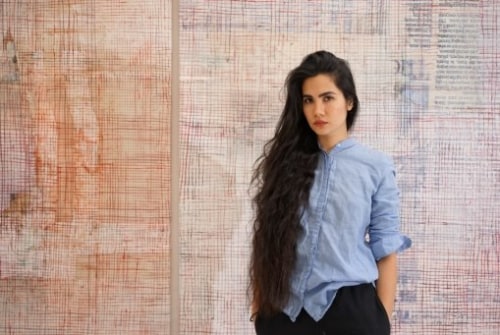
With the impending winter melancholy yet awaiting behind glitter-laden holiday vitrines and a few illusively warm afternoons, art galleries contribute to the season’s festivities with ambitious solo exhibitions, showcasing the newest by art world key players and emerging talents. Bookended by the fall’s back-to-school shows and Art Basel Miami, which will haul the global art-goers to American south in early December, Chelsea galleries burst with delights to discover. Amongst tens of offerings behind the glass doors of many heavy-lifters, three European women artists pump fresh blood to the itinerary of gallery-hoppers.
Perched a few blocks north of the compact gallery radius is Sean Kelly, where Brooklyn-based German-Brazilian painter Janaina Tschäpe blankets the gallery’s soaring walls with her lush abstract paintings, absorbing the viewer into potpourris of color and form with her first show at the gallery. Doing justice to the exhibition’s playful title HumidGray and ShadowLake, the paintings defy adjectives and definitions, merging faint depictions of nature with hallucinatory eruptions of watercolor. The painter’s misty palette and oozing color marks bear dream-like renditions of uncharted territories, where birds or trees appear near abstraction, tracing Tschäpe’s loose hand gestures and fluidity of the painting agent. The artist attributed this freedom to her hand over paper the first time she saw a naked male model during a drawing class at the age of 14.
“I detached myself from the figure as I got more secure with the brushes and the pencils. That training was the base for me to be able to let go of the figure and dive into a more loose and abstract calligraphy,” she remembers. Those who pay attention to her acumen to render fluidity over large canvases with spontaneity will immerse in Tschäpe’s otherworldly universe of nocturnal lakes and ruby forests.
Tracking High Line’s winding path, you will reach Metro Pictures, where Danish-born and Berlin-based artist Nina Beier fills the gallery’s first floor with her uncanny sinks stuffed with hand-rolled cigars through their pipes. Each titled Plug, the corporal drainage apparatuses resemble faces, body parts or things in between, benefitting from the inevitable sexual pun of their voluptuous forms and penetrated holes. They radiate sexual charm with their sleek surfaces and bodily silhouettes in contrast to their primary hygienic purposes.
“I scratch and punch objects to see if they will swell and bulge. I pierce holes and turn them inside out, soak them and dry them out, flatten or inflate them, introduce them to other objects or isolate them. I basically try to find a way to open them up.” says Beier, who furthers her toying with everyday utilitarian objects with Baby, a wall-fixed waterbed stuffed with pebbles, coins, and, of course, water, resembling a pregnant body nearing her breaking point on the belly. Tschäpe’s utilization of voluptuous forms with slight references to corporality echo in Beier’s manipulation of the mundane.
Furthering two artists’ experiments with emblems of the everyday is Mandy El-Sayegh with her U.S. debut exhibition, MUTATIONS IN BLUE, WHITE AND RED, at Lehmann Maupin, where pink-hued pages of The Financial Times shroud a portion of the gallery interior. The London-based artist re-purposed the seminal British newspaper as wallpaper due to its formal and conceptual specificities, which include the paper’s status as a “British version of a ground and a signifier of global economic objectivity.” The color’s alikeness to flesh raises a question about the position of the body amidst fluctuating socio-economic landscapes. A headline about Brexit appears next to glowing sales of luxury cosmetics products in Asia, for example. Akin to an allusion to the body in Beier’s sculptures, El-Sayegh’s mixed-media paintings blend sexuality and body politics with cultural codings, yet with heftier accents on unstable global politics and media reportage on this incalculability.
“The inclusion of a spectrum of low culture and pop references is meant as a dialogue between the specific to the more ubiquitous,” explains the artist, who also exhibits a series of personal and public ephemera alongside small latex objects inside vitrines. “It’s a method for relating the domestic into canonical forms of western visual art culture and exploring forms through an experiment of zooming in and out of the individual and collective.” The artist’s vast sources of media and references orchestrate a mosaic of equally personal and composite narratives, surrounding the audience with a visual lexicon freed from a single narrative.
